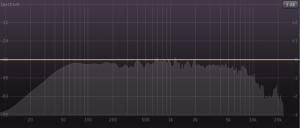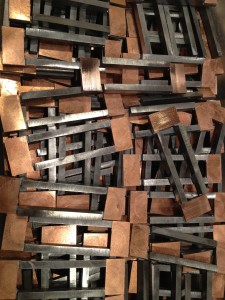In other words, why would I bother spending my time doing such a thing? Well, the answer is simple. I needed one, and there was nowhere to buy it. My musical conspirators and I really wanted to play in the same room, at the same time, and still get great sounds on tape (or on hard disk). Horns and drums together? No problem. Guitar amps and drums? No problem. Piano and drums? No problem. Upright bass and drums? Problems. Bad problems. The un-amplified bass is just not loud enough to hold it’s own, even using a close mic, and still let the drummer play expressively and with full dynamic range. Or so I thought, for a long time. Then one day I tried a figure 8 pattern ribbon microphone in my favorite spot, hanging in the bridge. Wow. When I soloed the track, I thought I had mixed up the pickup and mic tracks. When I got it straight and compared the two, the bleed in the microphone was not dramatically different from the bleed in the pickup (the bass becomes a giant microphone when you connect a contact mic to it….). So! I went looking for an affordable small lightweight ribbon microphone. Oops. There weren’t any. SO…. I bought a ribbon microphone kit, took apart some inexpensive ribbon mics, and mocked up a couple mic bodies using parts a of a broken hang glider (don’t ask). After a coupla few tries, I had a pretty good microphone on my bass. I used one of these early versions to record in my own studio, and some really nice professional studios. I got more and more promising results with each session. Next step? The details. Reading books on microphone design, lots of reading the interwebs, lots of asking questions of my artisan friends who can make anything, and drawing heavily on my background as a MacGyver impersonator, I worked out the details, one at a time. This is a handmade product, and it is designed to be as minimal in size and weight as possible. The transformers used are made in the USA, all the machine work is done locally in the SF Bay Area, the windscreens are produced in the USA, and I hand assemble and test each microphone. I’m pretty sure the wire and XLR connectors are made overseas, but hey…
WHY BUY A TROLL?
You should buy a Troll because you; love the sound of classic recordings of upright bass; value handmade craftsmanship; want to benefit from the intense obsession of one upright bassist to make a better sound; value the permanence of an item, and prefer to repair rather than replace; can’t resist the clever name; record acoustic music, and need a better way to capture the bass; play acoustic music, and have had no luck with standard mic setups for live use; have to own every new piece of bass gear; have your own reasons I haven’t thought of!!
WHY MAKE A FREQUENCY RESPONSE CHART?
Well, because several people have asked for it. Most people I know don’t refer to the frequency response chart when they talk about why they love their favorite microphones. That being said, it is somewhat informative to “see” what’s going on with a microphone. The following chart was created using a calibrated real time pink noise method, rather than the burst/Fourier technique. 


Comments on this entry are closed.